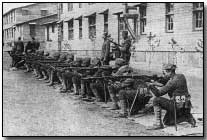Weapons of War - Bayonets
 According to tradition the bayonet was developed in Bayonne, France, in the early 17th century. That it was
still apparently in commonplace use during the First World War may seem
incongruous when compared to leaps in technological warfare typified by
artillery, grenades and
poison gases. Nevertheless the bayonet was
used by all sides from 1914-18, even if its use was more psychological than
practical.
According to tradition the bayonet was developed in Bayonne, France, in the early 17th century. That it was
still apparently in commonplace use during the First World War may seem
incongruous when compared to leaps in technological warfare typified by
artillery, grenades and
poison gases. Nevertheless the bayonet was
used by all sides from 1914-18, even if its use was more psychological than
practical.
Used to Stoke the Fire
Veterans of the Great War, when interviewed, tended to play down the impact of the bayonet during the war. Many remarked (partly in jest) that the bayonet was used primarily as a splendid means of toasting bread, and for opening cans, to scrape mud off uniforms, poking a trench brazier or even to assist in the preparation of communal latrines.
It therefore begs the question: was the bayonet of any real significance during the war, and if not why was it carried by virtually all infantrymen in all armies (and most especially by the usually technologically advanced German army)?
Simple Design
The German army developed more types of bayonet than all other armies combined. They produced special adaptors so that captured enemy bayonets could be fitted to the common Gewehr 98 rifle.
In essence a bayonet is simply a simply a blade that is attached to the barrel of a rifle for use in close combat.
 Most
bayonets were of simple design, of the knife variety, although variations
existed. For example the French devised a needle blade for use on
Lebel rifles. Notoriously, the German army produced a 'saw-back' blade
that, as its name suggests, gave the appearance of a saw with its double row
of teeth on the back edge.
Most
bayonets were of simple design, of the knife variety, although variations
existed. For example the French devised a needle blade for use on
Lebel rifles. Notoriously, the German army produced a 'saw-back' blade
that, as its name suggests, gave the appearance of a saw with its double row
of teeth on the back edge.
Produced chiefly for use by engineering units for specific tasks, the saw-back blade proved a blessing for Allied propaganda purposes. Keen to represent the Germans as ruthless, blood-thirsty 'Huns', the popular press widely propagated the notion that this type of bayonet had been specifically developed as a refinement of German brutality for use in close combat.
Although it could doubtless be put to such use, it was actually designed to be used as a saw when the need arose.
Personified the Offensive Spirit
 In many ways the bayonet was a throwback to the concept of an aggressive method of warfare.
In many ways the bayonet was a throwback to the concept of an aggressive method of warfare.
Used traditionally by the colonial powers such as France and Britain in combat against far less well-armed adversaries, it was deemed a positive example of a co-called 'offensive spirit'.
Given that the French pre-war blueprint for war, Plan XVII, required an abundance of offensive spirit from the French army in their planned conquest of Alsace and Lorraine, the bayonet must have seemed an ideal weapon for the coming war.
In reality however it transpired that technological advances in defensive warfare had outstripped those of offensive warfare. The machine gun held sway over the battlefield. Infantry advancing with bayonets affixed to rifles were invariably mown down before they reached enemy trenches. The opportunity to use the bayonet was thus much restricted.
Even when a raiding party had reached the enemy position the role of the bayonet was often primarily one of guarding the grenadiers among their party, whose task was to race down the trench lobbing hand grenades into dugouts as they passed. Indeed, bombing parties invariably contained at least two 'bayonet men' whose job was solely to defend the bombers.
One advantage of using a bayonet in close crowded combat, as opposed to a rifle or hand-gun, was its avoidance of risk in injuring one's fellow soldiers. A bullet fired at close range into an enemy could well pass through his body and enter a friend standing (or fighting) behind him.
Close Combat Fighting
 Of
course there were still many occasions when close combat fighting was
necessary.
Of
course there were still many occasions when close combat fighting was
necessary.
This was the ideal scenario for the use of the bayonet. Nevertheless, while it was seldom actually used, experienced soldiers generally preferring other methods, carrying improvised clubs, blades or knuckledusters.
Curiously the official British bayonet training manual gave poor advice regarding the bayonet's usage. Soldiers were instructed to direct the bayonet at the vulnerable points of the enemy's body: the throat, left or right breast and left or right groin.
Aiming the bayonet blade at the breast ran the risk of driving into the breastbone, making removal of the blade highly problematic. Similarly, aiming the blade at the groin inevitably resulted in excruciating pain to the victim, such that they would often grab the bayonet in an attempt to pull the blade out. In such cases soldiers often had to remove the blade from the rifle simply in order to continue with the attack.
There was undeniably psychological value to the infantry in carrying a bayonet, even if in practice it was seldom used. Bayonets continued to be commonly issued in the Second World War.
Photographs courtesy of Photos of the Great War website
Bulgaria mobilised a quarter of its male population during WW1, 650,000 troops in total.
- Did you know?
